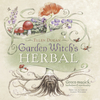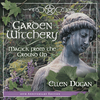Beltane's Garden

Looking for something outdoorsy to do this Beltane? (Something that doesn't involve running around in the fields with randy strangers, that is?) How about turning your attention to your garden?
May is a magickal time for gardens; Beltane is a fertility festival after all, and this is the time of year when gardens really start to exhibit that trait. Many people believe that, as with Samhain, the veil between the worlds is thinner at Beltane. Why? Because it is a threshold place, a time of year that does not belong to winter or to summer. At Samhain, it is a time of decay; at Beltane, the return of life in full force. A time for growth and spiritual energy, indeed.
As such, this is a wonderful time to look to your garden, and work with it not just physically (the planting, weeding, fertilizing and so forth) but also spiritually. As Ellen Dugan wrote in Garden Witchery, "I find myself looking forward to the full moon in May; we call it the faery moon at my house. This is the night when I bless the garden and all of the herbs, flowers, plants, trees and vegetables we care for in our yard. Both Beltane and the faery moon are magickal times for gardens and gardening."
If you have a relationship with the faeries in your garden, now is a good time to work on that as well. Raven Grimassi, in Beltane, also writes about the connection of gardens, faeries and Beltane. "May is a season associated with buds and flowers. These reflect the theme of ever-renewing life. […] Throughout continental Europe and the British Isles a great deal of folklore concerning flowers has evolved over the centuries. Much of this type of lore is also associated with fairies. In the Old Religion of pre-Christian Europe is was believe that fairies helped open the buds of plants and cared for all growing things in general." You may want to leave some gifts out for the fae: shiny baubles, dishes of milk, or some of their favorite May flowers.
There are plenty of plants to watch for in May, either in your own garden or out and about. One of them is hawthorn, which, as Grimassi writes, "is known also as the May flower, May bush, May bloom or May tree. In Ireland the hawthorn was considered magical, and its blossoms were placed on the bedroom dresser to ward off illness. On the first of May it was once the custom to sprinkle hawthorn sprigs with holy water and set them in the fields to protect the crops from the fairies. In some of the oldest lore the hawthorn was a protective gateway to the fairy realm. […] It was once the custom in many parts of Europe to adorn doors, posts, and other parts of the home with hawthorn and other flowers on May Day." He also lists Lady's Smock, Lily of the Valley, and Marsh Marigold as flowers that were dedicated to the May Queen on May Day and incorporated in such garlands.
This May Ellen Dugan's long-awaited sequel to Garden Witchery is due to hit the bookshelves: Garden Witch's Herbal. In it you'll find herbs and flowers for each of the Sabbats (among other things!). So which ones does she choose for Beltane? Meadowsweet, well loved by the Fairies for its delightful scent; male fern, use in faerie magick, invisibility and protection magick, and much more; and two varieties of daisy, both symbolizing purity and innocence and thus being great for working magick for children or babies. They are also used in classic love and romance spells, and the ever-popular, "he loves me, he loves me not" divination.
If you don't have any of these plants in your garden or your neighborhood, don't worry. The most important thing to do as a witch is simply to get outside and let the sap-like elixir of spring run through your own veins. Take a moment to appreciate this threshold between seasons, this brief window in time before the heat of summer slows you down, the mosquitoes start biting, and the fruits start growing. Enjoy the buds and the blossoms, those delicate, short-lived treasures, and have a magickal Beltane.
Related Products



is subject to certain Terms and Conditions